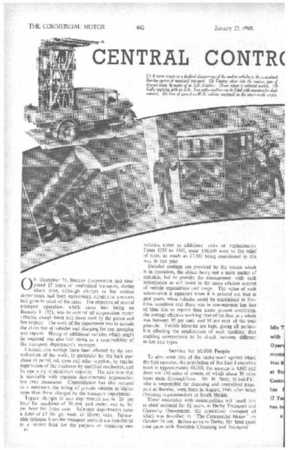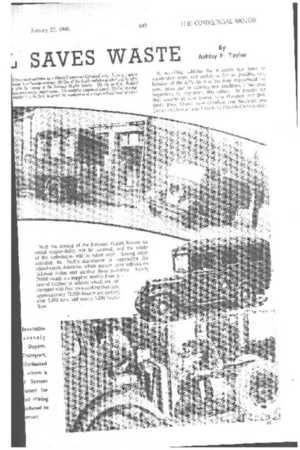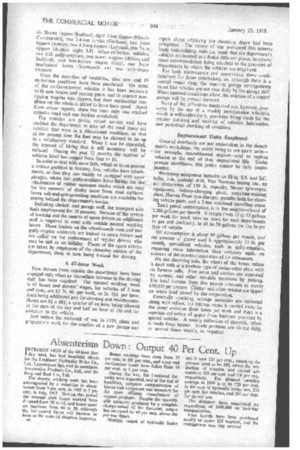CENTRAL CONTR.( SAVES WASTE
Page 38

Page 39

Page 40

If you've noticed an error in this article please click here to report it so we can fix it.
By Ashley F. Taylor 0 N December 31, Burnley Corporation had completed 17 years of centralized transport, during which time, although charges to the various departments had been economical, substantial amounts had gone to relief of the rates. The objective of central transport operation, which came into being on January 1, ln 1, was to control all corporation motor \ ehicles, except buses and those used by the police and fire brigade The work of the department was to include the allocation of vehicles and charging for use, garaging and repairs Hiring of additional vehicles which might be required was also laiddown as a responsibility of the transport department's manager.
Considerable savings have been effected by the centralization of the work, in particular by the bulk purchase of petrol, oil, tyres and other supplies, by regular supervision of the machines by qualified mechanics, and by operating at maximum capacity. The idle time that is inevitable with separate departmental organization has been eliminated Centralization has also reduced to a minimum the hiring of private vehicles at higher rates than those charged by the transport department
Typical charges to user departments are 6s 2d per hour' for machines of 30 cwt and under, and 6s 9d Per hour for 2-ton units Sole-user departments incur a debit of £5 lOs per week for 10-cwt vans. Favourable balances from the transport account are transferred to a reserve fund for the purpose of acquiring new
vehicles, either as additional units or replacements From 1935 to 1942, some £10,000 went to the relief of rates, as much as £2,500 being contributed in this way in one year.
Detailed costings are provided by the system which is in operation, the object being not a mere matter of statistics, but to provide the management with such information as will assist in the more efficient. control of vehicle expenditure and usage. The value of such information is apparent when it is pointed out that in past years, when vehicles could be maintained in firstclass condition and there was in consequence less loss of time due to repairs than under present conditions, the average effective working time of the fleet as a whole was between 95 per cent. and 98 per cent of the total possible. Vehicle histories are kept, giving all particulars affecting the employment of each machine, thus enabling comparisons to be struck between different mikes and types.
Service for 80,000 People
To give some idea of the background against which the fleet operates, the population of this East Lancashire town is approximately 80,000, the acreage is 4,600 and there are 130 miles of streets, of which about 30 miles form main thoroughfares Mr M. Stott, M lnst.P.0 who is responsible for cleansing and centralized transport at Burnley, went there in August, 1946, after being cleansing superintendent at South Shields.
Those associated with municipalities will recall him as chief assistant for 8i years, in Derby Transport and Cleansing Department, the centralized transport of which was described in 'The Commercial Motor" On October 24 last. Before going to Derby, Mr Stott spent nine years with Rochdale Cleansing and Transport. With the coming of the National Health Service an added responsibility will be assumed, and the whole of the ambulances will be taken over. Among other activities, Mr Stott's department is responsible for school-meals .deliveries, which occupy three vehicles on full-time duties and another three part-time. Nearly 29,000 meals are supplied weekly from a ceni,a1 kitchen to schools which are not equipped with their own cooking facilities: approximately 22,500 dinners are carried, over 3,500 teas, and nearly 3,000 breakfasts.
In acquiring vehicles the intention has been to standardize types and makes as far as possible, but, because of the difficulty' that has been experienced for some years past in securing new machines, it has been impossible to implement this policy. Al present the fleet consists of nine 10-cwt. vans (Fordson and Bedford), three 30-cwt. vans (Fordson and Bedford), one 2-ton van (Austin), one 1-ton lorry (Morris-Commercial). six 30-cwt. tippers (Bedford), eight 2-ton tippers (MdrrisCommercial), two 3-4-ton lorries (Fordson), two 3-ton tippers (Austin), two 4-5-ton tippers (Leyland), two 5-t tippers (Austin) eight S.D. refuse-collection vehicles. two S.D. gully-emptiers, two tower wagons (Albion and Bedford), one breakdown wagon (Guy), one 3-ton mechanical horse (Scammell) and one ambulance (Austin).
Since the cessation of hostilities, nine new and 19 ex-Service machines have been purchased. On some of the ex-Government vehicles it has been necessary to fit new bodies and tipping gears, and to convert nontipping wagons into tippers, but their mechanical condition on the whole is stated to have been good. Apart from minor repairs, there has been only one cracked cylinder head and one broken crankshaft.
The vehicles are giving sound service and have enabled the department to take off the road Many old vehicle's that were in a dilapidated condition, so that at the present time the fleet may be.-claimed to be up to a satisfactory standard. When it can be expanded, the amount of hiring that is still necessary will be reduced During the past 12 months the number of vehicles hired has ranged from four to 10.
In order to deal with snow falls, which at times present a serious problem in Burnley, four vehicles have attachments, so that they can readily be equipped with snow ploughs, whilst two gully-ernptiers have fittings for the attachments of rubber squeegee blades which are used for the removal of slushy snow from road surfaces. Seven salt-and-grit-spreading machines are available for towing behind the department's lorries.
Including clerical and garage staff, the transport side finds employment for 58 persons. Because of the system of training and the reserve of spare drivers no additional staff is required to meet calls outside normal working hours Three loaders on the school-meals vans and two gully-emptier assistants are trained as spare drivers and are called on for replacement of regular drivers who may be sick or on holiday. Places of the spare drivers are taken by employees of the cleansing section of the department, these in turn being trained for driving.
A 47-hour Week New drivers from outside the department have been engaged only when an immediate increase in the driving staff has been required. The normal working week is 47 hours and drivers' wages, for vehicles of 2 tons and over, are £5 7s. 4d. per week, or 2s. 31d. per hour, there being additional pay for cleaning and maintenance. Hours are 8 a day, a quarter of an hour being allowed at the start of the day and half an hour at the end for attention to the vehicle.
Just before the outbreak of war in 1939, plans and preparatory work for the erection of a new garage and repair shops adjoining the cleansing depot had been completed. The advent of war prevented :this scheme from materializing, with the result that the department's vehicles are housed in a dozen different places, in several cases accommodation being attached to the premises of departments by which the vehicles are employed.
For both maintenance and supervision, these conditionst are far from satisfactory, as, although there is a central repair Fhop, the separate garage arrangements mean that vehicles are not seen daily by the garage staff. When national Conditions allow, the erection of a central garage will be pressed forward.
Some of the difficulties mentioned are, however, overcome by the use of a weekly maintenance schedule, which is self-explanatory, provision being made for the regular cleaning and. washing of vehicles, lubrication; and periodical checking of condition.
Replacement Units Employed General overhauls are not undertaken in the department's workshops, the policy being to use spare units— for example, reconditioned engines—and to replace vehicles at the end of their depreciated life. Under present conditions, this policy cannot be fully implemented.
Workshop equipment includes an 8i-in. S.S. and S.C. lathe, 1-in, pedestal drill, Van Norman boring bar, an air; compressor of 150 lb. capacity, Stenor tyre-repair equipment, battery-charging plant, acetylene-welding plant, Harvey Frost tyre changer, paraffin bath for cleaning vehicle parts, and a 2-ton overhead travelling crane.
Total petrol consumption is in the neighbourhood of 5,200 gallons per month It ranges from 10 to 12 gallons per week for small vans on work for such departments as gas and electricity, to 45 to 50 gallons for the larger type of vehicle.
Oil consumption is about 90 gallons per month, and the amount of grease used is approximately 25 lb. per month, specialized vehicles, such as gully-ernptiers, requiring more lubrication than ordinary units, on account of the constant operation of air exhausters.
On the cleansing side, the whole of the house refuse is dealt with at a modern type of incineration plant with six furnace cells. Fine ashes and cinders are separated by screens, and other 3alvable materials by picking. The total income from this source amounts to nearly £10,000 per annum. Clinker and other residue are tipped on waste land owned by the corporation.
Generally speaking, salvage materials are collected along with refuse, but kitchen waste is carried away by the street orderlies three times per week and there is a separate collection of paper from business premises by special vehicles. A weekly collection of domestic refuse is made from houses. Trade premises are visited daily, or several times weekly, as required.












































































